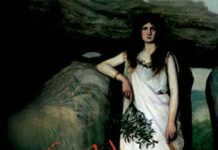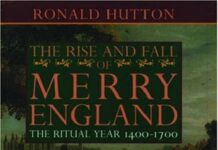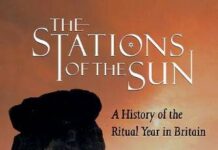
Ebook Info
- Published: 1993
- Number of pages: 422 pages
- Format: PDF
- File Size: 23.68 MB
- Authors: Ronald Hutton
Description
This is the first survey of religious beliefs in the British Isles from the Old Stone Age to the coming of Christianity, one of the least familiar periods in Britain’s history. Ronald Hutton draws upon a wealth of new data, much of it archaeological, that has transformed interpretation over the past decade. Giving more or less equal weight to all periods, from the Neolithic to the Middle Ages, he examines a fascinating range of evidence for Celtic and Romano-British paganism, from burial sites, cairns, megaliths and causeways, to carvings, figurines, jewellery, weapons, votive objects, literary texts and folklore.
User’s Reviews
Editorial Reviews: Review “An excellent, up-to-date compendium of British pagan religions based primarily upon recent archaeological findings. Hutton has contributed a well documented resource which has popular interest.” Library Journal”Brilliant … Hutton’s book gives us by far the best, most level-headed overview of this fascinating but contentious subject.” Times Literary Supplement From the Inside Flap This is the first survey of religious beliefs in the British Isles from the Old Stone Age to the coming of Christianity, one of the least familiar periods in Britain’s history. Ronald Hutton draws upon a wealth of new data, much of it archaeological, that has transformed interpretation over the past decade. Giving more or less equal weight to all periods, from the Neolithic to the Middle Ages, he examines a fascinating range of evidence for Celtic and Romano-British paganism, from burial sites, cairns, megaliths and causeways, to carvings, figurines, jewellery, weapons, votive objects, literary texts and folklore. From the Back Cover This is the first survey of religious beliefs in the British Isles from the Old Stone Age to the coming of Christianity, one of the least familiar periods in Britain’s history. Ronald Hutton draws upon a wealth of new data, much of it archaeological, that has transformed interpretation over the past decade. Giving more or less equal weight to all periods, from the Neolithic to the Middle Ages, he examines a fascinating range of evidence for Celtic and Romano-British paganism, from burial sites, cairns, megaliths and causeways, to carvings, figurines, jewellery, weapons, votive objects, literary texts and folklore. About the Author Ronald Hutton was educated at Cambridge and then at Oxford, where he held a fellowship at Magdalen College. In 1981, he moved to the University of Bristol, where he is now Reader in British History. He is a historian of wide interests ranging from political affairs and popular culture to topics covering the whole of the British Isles. This is his fifth book. Read more
Reviews from Amazon users which were colected at the time this book was published on the website:
⭐Re: “We Don’t Do Sacrifices”: Pagan Gathering Concerns ChristiansOn August 2, 2002, the Ottawa Citizen ran a story entitled “We Don’t Do Sacrifices”: Pagan Gathering Concerns ChristiansThe article on modern paganism left me mildly amused,largely because of the views of its proponents. What’s the ‘scoop’ on modern paganism anyway? Is it a post-modern smorgasbord, or just a load of contemporary hype? For the “unenlightened”, the facts are most revealing.In his book “The Pagan Religions of the Ancient British Isles”, Ronald Hutton presents one of the most balanced, and historically valid accounts of modern paganism available. He observes that the past twenty-five years has seen an unusual growth in pagan-related books and the like, many of whichmake the indispensable claim of somehow being “Celtic”. A popular example of this can be found in the writings of Caitlin Matthews. Though her books serve up a virtual smorgasbord of arcane Celtic practices, calendric festivals and the like, there are few valid source-references for her claims. One fascinating revisionist technique she uses is to fuse these earlier Celtic “fire feasts” (such as August 1st) with the solstices andequinoxes, making eight festivals in total. This amalgamation, known as the “Wheel of the Celtic Year” is no more than a contemporary phenomenon, a product of modern witch cults. No known pre-Christian people celebrated all eight festivals of this calendar, until adopted by the modern Wicca movement. But it sure sounds yummy to those who WANT to believe it.Another earlier work that is often cited by modern (Celtic?) pagans is Robert Graves’ “The White Goddess” (1944). Drawing upon imagery from the Celtic and Graeco-Roman worlds, then adding his own personal religious notions and poetry, its metaphorical and mythological contents were passed off as historical fact. By presenting those who wanted to believe with a matriarchal religion in the form of a Celtic Great Goddess, while asserting that ancient societies were ruled by women, he became the hero of many modern day feminists. His ‘Celtic Tree Calendar’ was equally contrived in order to suit the appetites of this same contemporary audience. He later admitted: “It’s a crazy book and I didn’t mean to write it”. Evidently, Graves failed to warn his readers that it was a work of sustainedmetaphor, rather than that of literal truth.And what of “Wicca” and that symbol of modern paganism, the pentagram? Here again are examples of modern (re)invention, containing some fascinating new elements. To begin with, the word ‘wicca’ does not derive from the same root as that for ‘knowledge’, as many of its adherents would claim. Rather,it is simply the Anglo-Saxon word for a male witch (‘wicce’, being the female equivalent). Building on Graves’ (and other earlier) works, the 1960’s and 1970’s saw the publication of increasingly dubious materials, all of which perpetuated the Goddess-myth, relegating male Gods (or even Jesus Christ) to that of consorts. This was also the time frame which witnessedthe invention of the pentagram. Nonetheless, the modern pagan movement evoked a powerful new creed, one in which radical feminism, Wicca, and Wicca-related practices became intermingled with witchcraft, goddess worship and women’s rights, in effect blurring the line between religion and magic.The movement has certainly become one of the most eclectic on record. Rather than studying the past more closely, by the 1980’s it began incorporating a myriad of different beliefs. This curious ‘pix and mix’spirituality combined elements from Jungian psychology, North American aboriginal beliefs, eastern religious traditions, along with Celtic, Saxon and Norse mythology into a gigantic morass. Its practitioner unwittinglyextolled the virtues of a its new “inclusive” nature through the use of ‘craft lore’ (not to be confused with ‘oral tradition’), deemed by most Wiccan writers to be more important than historical evidence. In proceeding this way, it lost contact with the thought-worlds it deemed of central import, concentrating instead on its own insular thinking. More recently, I have heard of how followers of Wicca claim that Christians sometimes ‘borrow’ their beliefs. In reality, the reverse is true, as Margot Adler states: “the most authentic and hallowed Wiccan tradition [is] stealing from any source that didn’t run away too fast”. So is Wicca in somemysterious, even mystical way, “Celtic”? Absolutely not. Are present claims true, that modern paganism is a repository of “ancient wisdom”? Not unless you believe the mid-twentieth century to be ‘ancient’! In fact, modern paganism hasvirtually nothing in common with that of the past except the name, which itself is of Christian coinage. If they did “do sacrifices”, they’d at least be standing closer to reality. Modern paganism, in all its forms is truly “New Age”.Not surprisingly, the writings of contemporary pagans are characterized by an intense and consistent hostility towards the Christian church. And while Christians have good reason to be concerned, they should not be unduly alarmed. Because inthe end, all modern paganism serves up is a plate of gravy, leaving their bewildered followers to wonder – “where’s the beef?!!”Steeped as it is in fanciful claims of historical authenticity and shrouded in its own revisionist mantra, it represents yet another (albeit colourful) bit of contemporary hype. The Irish-Canadian poet, Thomas D’Arcy McGee, perhaps put it best by stating: “Through storm and fire and gloom I see it stand, firm and broad and tall, the Celtic Cross that marks ourfatherland, Amidst them all! Druids and Danes and Saxons vainly rage around its base; It standeth shock on shock, and age on age, star of our scatter’d race”.But it is our scholar Ronald Hutton who adds a real note of finality to the matter. Commenting on the arrival of Christianity into the Celtic lands,he states emphatically that “[Christianity]succeeded apparently because of the sheer power of the message being preached, to which the existing [pagan] religions had no effective answer”.
⭐This book is at once impressive and flawed. Despite its substantial flaws however, it is a book worth reading. Hutton has tried to produce a comprensive survey on the topic of pre-Christian religion in the British isles and while he has missed that mark substantially, the book is, in its own way, an important contribution to the field. The author’s biases against both schools of thought and academic disciplines deeply wounds this work, but treasures remain within it nonetheless.The most impressive parts of the book cover paleolithic and neolithic burial customs, art, and archaeology. In these areas, Hutton discusses in reasonable detail the archaeology of stone-age Britain. In these areas, Hutton is at his best: There is little that the fields that Hutton so obviously despises (comparative mythology, philology, etc) can tell us of these times so the few counter-examples are really not worth noting. In these areas the book is quite valuable in that it attempts to put together a basic picture of what is known.On the other hand, the portions concerning the pre-Roman Britons and pre-Christian Irish are mediocre at best. Hutton here finds conclusively rebutted by authors (such a Alwyn and Brinley Rees) who came significantly before him. In fact careful folklore surveys and philology have both shed a great deal of light on many areas of insular Celtic religion, at least in Ireland (and less so in Wales). This is, of course, understandable. Just as archaeology is a very technical discipline, so is philology. It is clearly too much to ask of Hutton that he masters both. Nonetheless, a casual reader would find it interesting how much the philologists and archaeologists disagree (this is a typical problem not limited to this work).Worse, Hutton gets a number of important points quite simply wrong. He states that Ogham existed prior to Christianization while all evidence we have today suggests that Ogham came out of post-conversion groups and was deeply influenced by the Latin alphabet and classical (Greek and Latin) rhetorical theory (see “A Guide to Ogham” by Damian McMannus). His discussion of Havamal and Odhinn is not much better (suggesting that the scene of Odhinn hanging from the tree is a transference from Christianity). What seems “obvious” to Professor Hutton seems to be based even less on structured inquiry and even more on personal taste than the largely abandoned theories of Gimbutas which he disparages.In essence his archaeology seems reasonably good, but his textual studies seem quite bad.On the whole, I would say that this book contributed significantly to my knowledge of the subject matter. I would recommend it to others but would caution the reader to understand that there is a significant bias to the work.
⭐This is a must have for anyone who wishes to read about re Christian /pagan Britain
⭐Bought as reference book for course, as described and excellent price.
⭐Love the book arrived in good time very happy
⭐Hutton is true scholar. You can’t go wrong reading his books in my opinion.
⭐I bought this book hoping I would learn something about `the pagan religions of the ancient British Isles’. I did not, other than a few crumbs here or there because at Hutton states on page 341 (the last page) we cannot know anything about them as ‘they perished along time ago and absolutely’. ‘They are lost to us forever’. So there we are, 341 pages saying we cannot know anything – and we – or at least Hutton, does not.I found this a very irritating book. Hutton appears to enjoy nothing more than demolishing the work of others. His principle target is the neo paganism that has sprung up in the last century, which in his view has no sound basis or lineage. He may be correct but the relish with which he goes about this task is not terribly attractive. He is a demolisher not a builder, which is the weakness of the book. Where he manages to provide content himself, it is mostly in the form of lists of things – like every ancient monument in the UK, or Roman gods. What he does not do is draw any insights from these lists that might shed some light on the answer the title of the book sets out to address. If Tescos can build a world class business by analysing customers shopping lists, I feel a decent scholar ought to be able to achieve a little more than Hutton does with the wealth of material available.Where he does come across evidence of the persistence of pagan customs he typically rejects it as being unlikely to have survived so long and therefore assumes it to be a recent creation. My recollection is that the Iliad was supposedly passed down by oral tradition for a thousand years, and the Vedas for even longer. Why then is it implausible that we Brits cannot remember through our tales and traditions customs dating back 1500 years?Hutton makes a distinction between magic – which he does agree has persisted, and religion, which in his view has not, however frankly the difference was lost on me, and comes across as about as useful a piece of academic hair splitting as debating how many angels you can get on a pin head. This does not of course mean that the particular example is not a pagan custom still in use, just that Hutton has not found anything in writing from the pagan past, complete with a date stamp to provide authentication. With such a high requirement of standard of evidence, nothing gets through his filters, and in fact he asserts that the Irish legends are little more than Christian stories as they were originally written down by Christian monks – with that conclusion there is clearly no need to study them further. In a similar vein, all British myths and customs are written off as little more than Greco-roman remnants – therefore again no value no further study. The Norse legends or similarly dispatched. My own recollection of the ancient stories that I have read is that this is not such an obvious conclusion. Nowhere does he provide any detailed arguments for these sweeping generalizations, nor does he go in for the kind of deep forensic analysis and cross referencing from multiple sources that is needed to start to unravel our Pagan past. We are, I assume, supposed to agree with his conclusions because as he frequently points out he is an `academic’ as opposed to the mere amateurs that have dominated the field to date. One is therefore left unsatisfied by this rather shallow book. He does a successful demolition job on a lot of new age nonsense, but does not come up with anything better to replace it. Regrettably I bought two books by him from Amazon – I hope the second is better.
Keywords
Free Download The Pagan Religions of the Ancient British Isles: Their Nature and Legacy in PDF format
The Pagan Religions of the Ancient British Isles: Their Nature and Legacy PDF Free Download
Download The Pagan Religions of the Ancient British Isles: Their Nature and Legacy 1993 PDF Free
The Pagan Religions of the Ancient British Isles: Their Nature and Legacy 1993 PDF Free Download
Download The Pagan Religions of the Ancient British Isles: Their Nature and Legacy PDF
Free Download Ebook The Pagan Religions of the Ancient British Isles: Their Nature and Legacy





